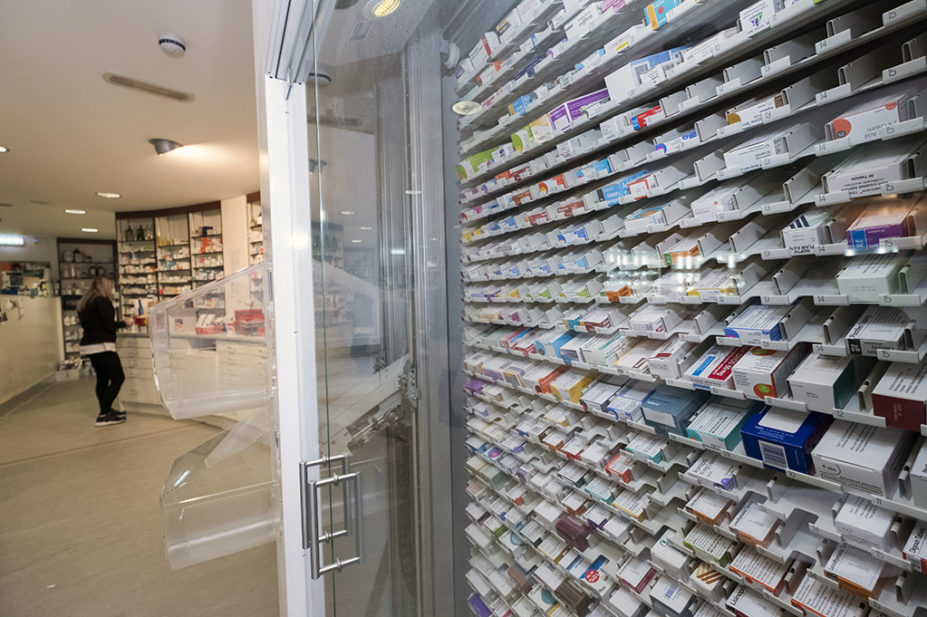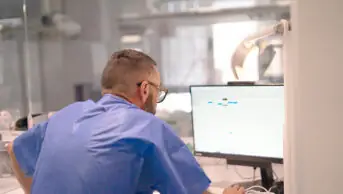
Lewis Houghton / Science Photo Library
All GP practices in England have been able to prescribe schedule 2 and 3 controlled drugs electronically since March 2019. This was introduced to reduce errors, ensure prescriptions are kept secure and cannot be misplaced, and to lessen the administration burden on GP practices and community pharmacies.
Electronic prescribing is also being gradually rolled out in the secondary care setting, as part of NHS England’s commitment in the ‘NHS long-term plan’ for the health service to be able to prescribe electronically by 2023–2024. In September 2020, the government said that around 130 NHS trusts had already introduced this system, with more to follow.
However, in our experience, some hospitals often decide not to use digital processes for controlled drugs prescribing. This is partly owing to cumbersome legal requirements, but also because of a lack of nationally recognised guidance on how to use electronic prescribing for controlled drugs most effectively.
This is a missed opportunity. In this article, we outline what needs to change to make the prescribing of controlled drugs in hospital less bureaucratic and safer for patients, and how pharmacists can help in this effort.
Complex legislation
The legal confusion around controlled drugs is a barrier to change. Anyone familiar with the requirements in the Controlled Drugs Regulations published in 2006 and the later so-called ‘Shipman regulations’ brought in in 2013 — following the recommendations of the inquiry into the infamous crimes of GP Harold Shipman — will tell you how complex they are[1,2]. However, we believe that this has resulted in undue caution in exploiting the opportunities that automation and digitalisation of controlled drugs can bring.
The legal framework we work within for controlled drugs is designed to reduce criminality arising from misappropriation; however, technological developments can in fact be supportive in reducing this problem by recording steps in the handling of controlled drugs and still enabling access for patients to this important medication.
In hospitals, controlled drugs create a considerable burden of paper-based administration, such as the ordering, dispensing and transporting of controlled drugs, nurse- and pharmacist-based routine stock checking, the governance of stock levels and their approval. Stock security is the responsibility of pharmacists and ward managers, and the potential for stock diversion is an understandable cause for concern. Indeed, The Pharmaceutical Journal reported that there were almost 3,000 reports of “unaccounted-for losses” of controlled drugs within the NHS in England during 2018–2019[3].
As a result, staff training and the maintenance of controlled drug policies and Standard Operating Procedures (SOPs) are a considerable workload for organisations. The handling of controlled drugs within the hospital setting requires skill and attention to detail because it can be fraught with problems. The routine management of the supply chain requires considerable staff time, skill and compliance in meeting legislative requirements. The technical skill in prescribing requires detailed knowledge, and the selection and dosing of these medicines requires experience and understanding of the complexity of the therapeutic package.
Technological solution
Despite the complexity surrounding legislation, there are a range of new technologies on offer involving automated dispensing cabinets and digitalisation, which can be used in pharmacy and clinical areas. These systems require no major change in the legal framework for their implementation, but they can go a long way in reducing the complexity of handling controlled drugs.
We believe that frequently it is the interpretation of the law that leads to bureaucratic processes. An example of this problem relates to the writing of prescriptions on discharge from hospital. It is a commonly held belief among hospital pharmacists that the whole discharge prescription containing a controlled drug must be written by hand, whereas, in fact, it is only a ‘wet signature’ on an electronically generated prescription that is required by law[4,5]. In addition, controlled drug prescriptions may be signed by another prescriber and still be legally valid, although the address needs to be applicable to the signatory for the prescription and the register entry should record the detail of the actual prescriber (i.e. the signatory) rather than the named prescriber.
In primary care, the need for a wet signature on a prescription has been replaced with an electronic version of prescription authorisation and yet, in hospital, there remains a legal requirement for a wet signature authorising the discharge supply of controlled drugs. It is often discharge prescriptions involving controlled drugs that hold up patient discharge but, by implementing an electronic system in place of the wet signature of a prescriber on an electronically-produced discharge prescription, it would reduce these time constraints by enabling all the prescribing to be completed online.
Pharmacy role
All chief pharmacists and regional pharmacists are under pressure from their organisations to improve efficiency of services — this shouldn’t just relate to their own pharmacy departments and staff, and should include the handling of controlled drugs.
Implementing automated and digital systems to reduce workload and increasing the ability to comply with the law and reduce criminality has been placed in the “too difficult” box in many, but not all, hospitals. Automated systems reduce criminality because they reduce the opportunities for manual handling of medicines. Use of the products is tracked by issue, recording the name of the user, the time, and the date at which the transaction occurred. When losses are investigated, a clear transaction trail can be produced that distinguishes between different users.
We believe every hospital should be reviewing its handling of controlled drugs and implementing automated and digital systems to reduce the workload associated with these medicines and to improve governance in the hospital setting.
Updated guidance
To achieve and deliver this, we believe a national controlled drugs policy for hospitals is urgently needed. This should include national SOPs and an NHS-wide training programme for all staff who handle these medicines.
Current guidance also requires updating. For instance, the Royal Pharmaceutical Society’s ‘Medicines, Ethics and Practice’ should be updated to state explicitly that ordering of a controlled drug may be done electronically[6]. The term “signature” in this guidance also needs to be clarified; for instance, that when the order is sent via electronic means, a signature can be electronically captured.
Guidance should acknowledge exceptional ‘real world’ circumstances, such as the rare (but allowable) situation in which requests for the administration of a schedule 2 or 3 controlled drug are made verbally; for example, in A&E departments, and are then followed up retrospectively in writing.
In some centres, such as Chesterfield Royal Hospital NHS Trust and Leeds Teaching Hospitals NHS Trust, investment in new technologies has included automated dispensing systems in pharmacies, wards and departments, linked to digital systems that include the handling of controlled drugs. Investment into these technologies should be occurring now in all secondary care environments to avoid the bureaucracy of paper and keys, and to contribute to infection control during the COVID-19 pandemic.
As always, innovative practice pushes the boundaries of interpretation of legislation, which is invariably late to catch up. An example of this is through the routine electronic ordering of controlled drugs based on a pre-determined stock level rather than through a manual stock count and paper-based ordering. New technologies, which can track the usage of a controlled drug and orders the stock required at a pre-determined stock level, should be recognised within the legal framework and guidance.
These systems can make the handling of controlled drugs more efficient and secure. For example, having the messenger transporting controlled drugs from the pharmacy to a clinical area using a digitalised system for recording their movements.
It is time for a nationally recognised, consistent approach to automation and digitalisation in the handling of controlled drugs to bring the handling of controlled drugs into the automated digital age. We believe this is necessary to improve patient safety through the reduction of errors and adverse drug events, and improve security at the same time, as it has in other areas of prescribing[7].
Declaration: The authors declare that they were funded by Omnicell to write another article appearing in The Pharmaceutical Journal entitled ‘How to handle controlled drugs in hospitals using automation and digital systems’. This is an independent review of the legislation surrounding the handling of controlled drugs in hospitals and offers the reader information about automation. The funder had no input into the content of this, or the current, article.
- 1The Controlled Drugs (Supervision of Management and Use) Regulations 2006. legislation.gov.uk. 2006.https://www.legislation.gov.uk/uksi/2006/3148/contents/made (accessed Mar 2022).
- 2Controlled Drugs (Supervision of management and use) Regulations 2013. Department of Health. 2013.https://assets.publishing.service.gov.uk/government/uploads/system/uploads/attachment_data/file/214915/15-02-2013-controlled-drugs-regulation-information.pdf (accessed Mar 2022).
- 3Open to abuse: gaps highlighted in the controlled drug system. The Pharmaceutical Journal. 2019. doi:10.1211/pj.2019.20207251
- 4The Misuse of Drugs Regulations 2001. legislation.gov.uk. 2001.https://www.legislation.gov.uk/uksi/2001/3998/contents/made (accessed Mar 2022).
- 5The Human Medicines Regulations 2012. legislation.gov.uk. 2012.https://www.legislation.gov.uk/uksi/2012/1916/regulation/217/made (accessed Mar 2022).
- 6Medicines, Ethics and Practice (MEP). Royal Pharmaceutical Society. 2021.https://www.rpharms.com/publications/the-mep (accessed Mar 2022).
- 7Impact of electronic prescribing on patient safety in hospitals: implications for the UK. Pharmaceutical Journal. 2016. doi:10.1211/pj.2016.20201013


